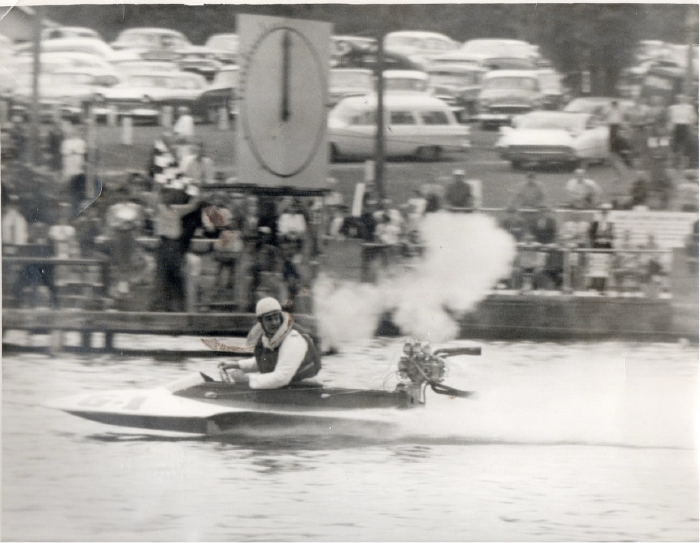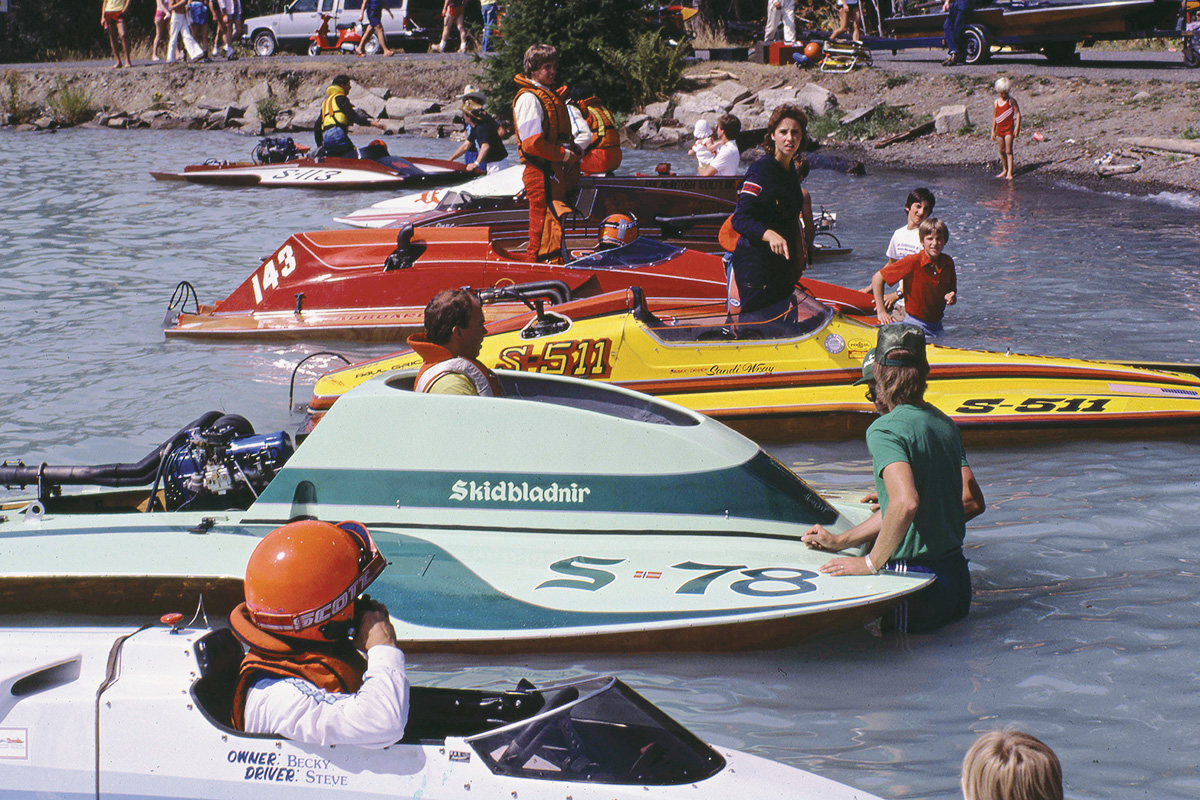Restoration of The Squire Shop
January 24, 2022 - 4:32pm

The Squire Shop at a pre-season test in 1979. Photo by Randy Hall
By Craig Fjarlie
Bob Steil owned a chain of young men’s clothing stores in the Pacific Northwest, called The Squire Shop. He knew that Unlimited hydroplane racing would be a good way to give his stores more public exposure. Steil made his entry into racing in 1977 with a used boat. He bought a new boat in 1979, designed by Dave Knowlen and built by Norm Berg. Chip Hanauer, who had driven Steil’s previous boat, was named as the driver. The same year, the Miss Circus Circus team had a new boat, also designed by Knowlen and built by Berg. Steve Reynolds was the driver. With the exception of paint schemes, the boats were virtually identical and they were frequently called the Berg twins. Both were cabovers, powered by Rolls-Royce Merlin engines.
Hanauer was a champion driver in smaller classes, and The Squire Shop was expected to give him an opportunity to score his first victory in an Unlimited. Bill Muncey was Hanauer’s top rival. Muncey was in the new “Blue Blaster” Atlas Van Lines and it was clearly the fastest boat that year. Things finally came together for Hanauer and The Squire Shop at a late-season regatta near Ogden, Utah. He won that race again in 1980. Hanauer drove The Squire Shop to his third career victory at Tri-Cities, Washington, in 1981.


The Squire Shop in 1979, with Chip Hanauer driving, by Bill Osborne.
A new race was planned in Acapulco, Mexico, in 1981. It would be the final event of the season. A few weeks before the Acapulco race, Hanauer was testing The Squire Shop on Lake Washington. At high speed, the boat flipped. “It almost killed Chip,” recalls David Williams, the Executive Director of the Hydroplane and Raceboat Museum in Kent, Washington. “He had a parachute on. He came out, the parachute got tangled in the boat. The boat was all wood, not enough flotation, and it started to sink. As the boat was going down, (rescue worker) Eric Steilau had to cut his life jacket off, so the boat could sink with the life jacket.” Steil’s team needed another boat in a hurry if they were going to race in Acapulco. The Miss Circus Circus had been sold to Al Letcher at the conclusion of the 1980 season. Letcher had been racing it as Spirit of the Air Force. Steil quickly bought that boat from Letcher and turned it into The Squire Shop. The replacement for the damaged boat went to Acapulco, and raced in 1982 with Tom D’Eath in the cockpit.
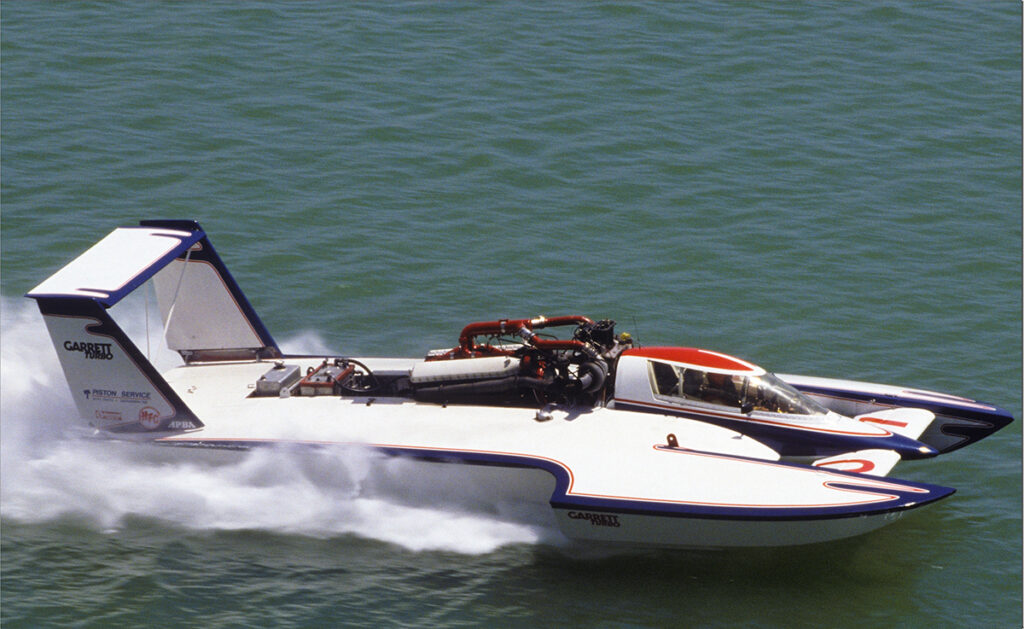
Above, the boat in 1990, with no name, by Bill Osborne.
Below, the boat in Detroit in 1991 with the name Miss Sundek, by Bill Osborne.
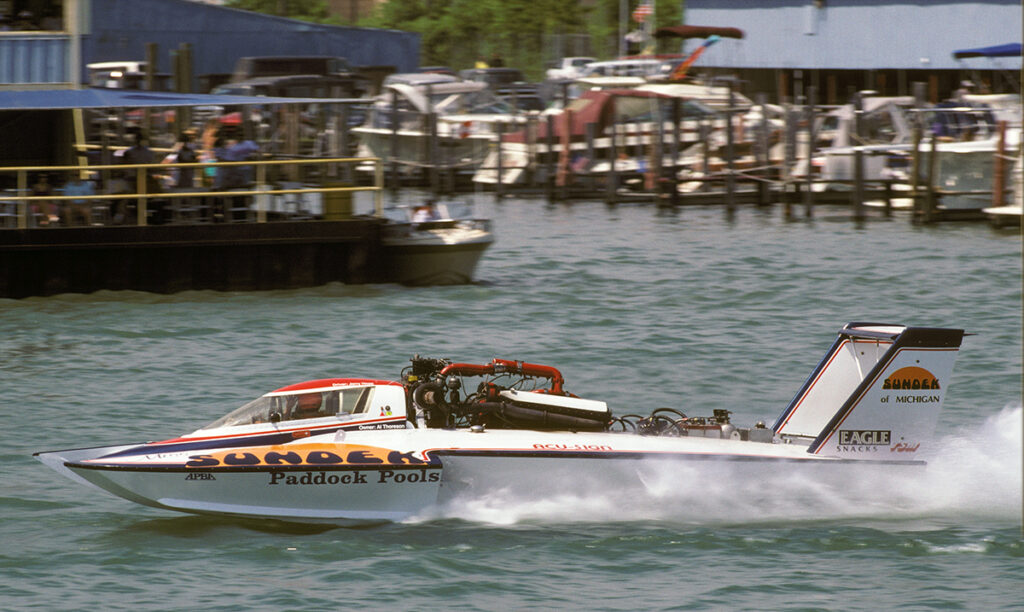
The Squire Shop that had flipped in 1981 was eventually repaired and purchased by Al Thoreson. It was fitted with an enclosed cockpit and powered by a turbocharged Allison. Jerry Hopp was the driver for several years during the 1980s and ‘90s. At that time, the boat was clearly outclassed by turbine-powered unlimiteds. When its racing days were over, the boat sat on a trailer for many years on Washington’s Olympic Peninsula. Slowly, it deteriorated.
About five years ago, a combination of circumstances came together so the Hydroplane and Raceboat Museum could restore the craft and return it to running condition. David Williams explains how the boat was saved. “Scott Carson was on the board of directors of a small wooden boat museum in Port Townsend, and this boat was at Ray Forsman’s place, on the peninsula. Scott went up to look at it and came back and said, ‘You can’t restore this one, it’s too far gone.’ We were dealing with Bob Steil; he was financing it. Bob came up with the money and we bought the Circus Circus hull from Dave Bartush in Detroit and brought it here. We were preparing to restore that, because it did race in ’81 and ’82 as The Squire Shop.” Had the Museum restored that boat as The Squire Shop, it would have produced a quandary. “We didn’t want to do that, because then the Circus hull would be lost,” Williams explains. “Gary Laws, Doug Brown, and Brad Haskin just loved this hull and didn’t want to see us skip doing the Squire hull and just do the Circus-Squire.”
Another individual entered the picture at that time. “While we were hemming and hawing, The Squire Shop hull was sold to Jim Dickinson,” Williams says. “Jim had it, but he wasn’t strictly vintage. He’s a big fan of the Ford V-12 tank engine. He thought he could take the Ford V-12 tank engine, put some blowers on it, and make it a really dynamite engine. He had visions of using this hull as a test bed for that engine project and eventually doing something contemporary with that engine. I talked with him, Brad talked with him, and Gary talked with him. He let us know that what he was really interested in was a round nose hydroplane. He would be willing to trade the ’79 Squire for some type of round nose.”
Finally, things began to come together so The Squire Shop of 1979 could be restored. “Gary Laws was the head of a group of five investors who all together came up with about $5,000,” Williams continues. “They bought the Tahoe Miss, traded it to Jim Dickinson for The Squire Shop, and then donated The Squire Shop to us.” Williams is clear that the Hydroplane and Raceboat Museum owns The Squire Shop. “The Museum owns the boat. We’re very, very grateful to the Laws family and Doug Brown who all contributed money to buy the boat and donate it to the Museum.”
The Hydroplane and Raceboat Museum has been working on restoration of the boat for a considerable length of time. “We’re a little over five years at this point,” says John Watkins, crew chief of the restoration effort. “We started with the original boat, tearing off stuff that wasn’t original or totally gone. We ended up with just a small piece of the bottom that was still original and usable, and it was totally oil-soaked, so there was nothing we could build back from. I re-lofted the boat from Dave Knowlen’s original scale drawings and salvaged what we could from some of the original hardware. There are some parts in there that are original, but we had to basically build a whole new wood structure. It had sat outside for 20 years. It literally had mushrooms growing out of it when we brought it in.”
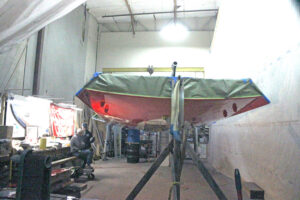
The Squire Shop at the Hydroplane and Raceboat Museum on January 15, 2022. The hull is upside down and the clear coat had just been applied. The clear coat covers and protects the paint. Photo by Craig Fjarlie
Work on the hull is now nearing completion. In mid-January, the clear coat was applied over the paint. However, there is still a great deal of work to do. “We have to install the engine, the engine compartment plumbing, a little bit of hardware to do on the shaft line, skid fin bracket, rudder bracket and a few things that get bolted on after painting,” Watkins explains. “The big things left are the cowlings and the wing, which are about ready to go into the paint stage.”
The engine is a separate project. “The engine is real close to final assembly,” Watkins says. Rolls-Merlin engines are difficult to find. “Steve and Mary Compton found this one for us,” Watkins says with a smile. “It belonged to George Czarnecki of Omaha, Nebraska, the engine builder for the vintage Miss U.S. IV.” Steve and Mary flew to Eppley Airfield to inspect the engine. “It was in wonderful shape, so they negotiated a great deal, wrote a check, loaded it into a rental truck, and brought it back to Washington State.” Steve and Tim Ramsey led the charge on the engine until Steve relocated to Tri-Cities. At that time, the Museum bought out the Comptons and the engine restoration was taken over by the Museum engine shop.
Watkins is looking forward to having the restoration project complete. “We hope in May,” he says with a hint of hesitancy. “You never know what you’ll run into.” Williams is less specific about a date for the boat to go in the water. “We’re going to get it in the water when it’s done, and no sooner than that,” he insists. “We need to get the engine done, we need to get a trailer done.”
Whenever the boat does run again, Williams and Watkins hope Chip Hanauer will be available to take it out “We hope to have Chip drive it first,” Watkins says. “It would be most fitting, if he’s available.” When The Squire Shop returns to the water, it’s certain to be thrill for a large contingent of fans, especially those who remember its racing days.
Featured Articles






